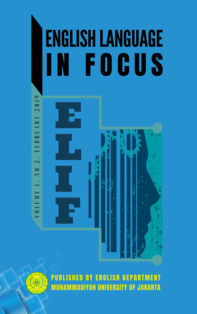The Use of Song in Teaching English for Junior High School Student
DOI:
https://doi.org/10.24853/elif.1.2.107-112Keywords:
song, English language, Junior High SchoolAbstract
The aim of this study is to investigate in detail the use of song in teaching English for Junior High School student. This study is action researches conducted at Dharma Karya UT Junior High School class VII with participant number are 25 students. Data obtained from the result of test in each cycle. The findings showed that the learning process using song makes the students become more active in their interaction, it is showed by their participation level during the teaching is increased. Another finding also revealed that there is a significant improvement in the student’s English language skills using song from preliminary to cycle II stage in the research process. The average score of students at the preliminary stage is only 60 then it increased to 68 in the first cycle and increased significantly in cycle II with the amount of 80. It can be concluded that action research is done by using song in teaching English for Junior High School significantly helps the students in increasing their English language skills. This study recommends the continuation of using various teaching media and tools for Junior High School student in order to improve their English language skills.References
Burns, A. (2010). Doing Action Research in English Language Teaching: A Guide for Practitioners. New York: Routledge.
Fairbanks, D. M. (2000). Accelerated Learning—Training Basics. USA: American Society for Training and Development.
Hare, K., & Smallwood, J. (2008). Music and Learning. Retrieved from http://www.kaizen-training.comlfree/TtT _Hare_Smallwood. pdf.
Horn, C. A. (2007). English Second Language Learners: Using Music to Enhance the Listening Abilities of Grade Ones. University of South Africa. https://core.ac.uk/download/pdf/43165719.pdf
Lo, R. S. M., & Li, H. C. F. (1998). Songs Enhance Learner Involvement: Materials Development. Forum, 36(3), 8-11.
Parlakian, R. (2010). Beyond Twinkle, Twinkle: Using Music with Infants and Toddlers, Young Children. National Association for the Education of Young Children, 65(2), 14–19.
Saricoban. (2000). Songs, Verse and Games for Teaching Grammar (TESL/TEFL). The Internet TESL Journal., 4(10). Retrieved from http://iteslj.org/Techniques/Saricoban-Songs.html
Schoepp, K. (2001). Reasons for Usings Songs in the ESL/EFL Classroom. The Internet TESL Journal, 7(2). Retrieved from http://iteslj.org/Articles/Schoepp-Songs.html
Scrivener, J. (2005). Learning Teaching : a Guidebook for English Language Teachers. Oxford: Macmillan.
Thornbury, S. (2002). How to Teach Vocabualry. Essex: Pearson Education Limited.
Downloads
Published
Issue
Section
License
Authors who publish with this journal agree to the following terms:
- Authors retain copyright and grant the journal right of first publication with the work simultaneously licensed under a Creative Commons Attribution License that allows others to share the work with an acknowledgment of the work's authorship and initial publication in this journal.
- Authors can enter into separate, additional contractual arrangements for the non-exclusive distribution of the journal's published version of the work (e.g., post it to an institutional repository or publish it in a book), with an acknowledgment of its initial publication in this journal.
- Authors are permitted and encouraged to post their work online (e.g., in institutional repositories or on their website) before and during the submission process, as it can lead to productive exchanges, as well as earlier and greater citation of published work (See The Effect of Open Access).


